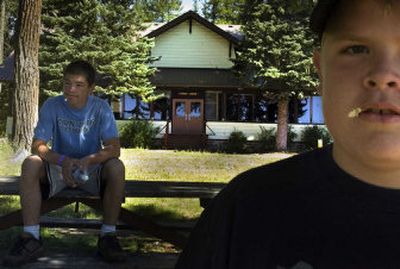Scouts building on rocky ground

A rustic dining hall at the Boy Scouts camp on Diamond Lake has sheltered thousands of boys from heat, snow and wind for more than 80 years. But Finch Lodge at Camp Cowles may be bulldozed and replaced with a new, multimillion-dollar dining facility if Scouting officials approve the project later this month.
A group of volunteers is trying to persuade the executive board of the Boy Scouts’ Inland Northwest Council to rehabilitate the building, which they call an important piece of local and scouting history. Although Scouting officials say renovation remains an option, they assert that constructing a new lodge would be cheaper and more efficient.
Built in 1923, the Craftsman-style lodge was designed by Spokane architect Julius A. Zittel, who also designed several landmark buildings, such as Spokane’s Carnegie Library. Zittel conceived a two-story building that accommodated 300 and featured ornate balcony railings, tongue-and-groove paneling and a large stone fireplace at each end. Volunteers added new siding and made other modifications over the decades.
Recent plans to convert Camp Cowles, the oldest portion of the roughly 900-acre Cowles Scout Reservation, into a Cub Scouts camp call for a larger lodge that can be used year-round, said Council Commissioner Mark Neupert.
For the lodge to remain, it would need an expansion and numerous upgrades, according to council documents. It would need new wiring and plumbing, for instance. An engineer who examined the building for the Scouts this spring reported that it is poorly insulated and doesn’t meet building codes. He recommended that it be demolished and replaced with a steel and concrete structure that maintains the “Finch look” architecturally.
A new building might cost $1.6 million to $1.8 million, whereas renovating the lodge might cost $3 million to $6 million, according to estimates listed in council documents. Another option would incorporate some materials from the old lodge into a new building.
The board is leaning toward a new building because officials are hesitant to spend money on historic preservation instead of programs, Neupert said
Yet Scouting volunteer and renovation advocate Greg Mott, who has been involved with Camp Cowles for about two decades, said rehabilitation isn’t receiving proper consideration. He said the council should restore the building and add a new kitchen and bathrooms.
Teaching appreciation for history is an important aspect of Scouting, he said.
However, David Luders, scoutmaster of Troop 171 and an engineer with the U.S. Air Force, said he favors a new building because the foundation is cracked, the building is an “icebox,” the second floor is unsafe and renovation would be too costly.
“Objectively, it is not worth it,” he said. “And I don’t think anybody can argue with that.”
Officials should plan for future Cub Scouts’ needs, he said.
“The kids don’t care about historic preservation, honestly. They really don’t,” he said. “They want to go to a place that’s nice and warm that they can use year-round.”
William Stacey Cowles, publisher of The Spokesman-Review and a member of the executive board whose ancestors donated much of the land for the reservation, said he and his family believe that the Scouts should use the property in the manner that best fills the needs of the program.
“I think the council has made a good argument that a Cub Scout camp makes the most sense for that particular area of the camp,” he said.
“It’s really tough to think about tearing down that old facility,” he said. “On the other hand, I think people have to weigh whether their memories are more important than the future of the Boy Scout program.”
Cowles said the most important decision facing the board is whether to model a new building after the current lodge or to start fresh.
Mott acknowledged that the lodge isn’t good for winter use but criticized the council’s cost estimates as imprecise.
He contends volunteers could help lower the price of renovation by doing demolition and other work.
He said church groups, Freemasons and wedding parties also have memories of the lodge.
“Finch Lodge is very important historically, even from a non-Boy Scout standpoint,” he said. “When it was built, it was considered quite the thing, and groups of all sorts have been using it since the beginning.”
Mott also said a new dining hall built elsewhere on the reservation in the late 1980s is plagued by maintenance problems, showing that new buildings aren’t always better.
Chris Moore, field director for the nonprofit Washington Trust for Historic Preservation, said he wrote a letter urging the council to preserve the building. Zittel was a noted architect, he said.
“Just from that standpoint, it represents a very rich architectural tradition that you have in Spokane and other areas of Eastern Washington,” he said.
Five buildings designed solely by Zittel are listed on the National Register of Historic Places, including the Mount St. Michael building in Spokane. A former state architect for Washington, he also designed the Carnegie Library, as well as buildings at Gonzaga and Eastern Washington universities; Old City Hall on Wall Street, which now houses the Olive Garden; and the Kootenai County Courthouse in Coeur d’Alene.
The board is scheduled to make a decision July 27.